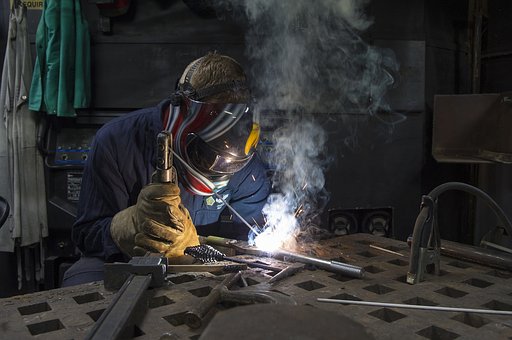
College, high schools unite to teach manufacturing
Manufacturing, a field with a quickly aging work force, may need young people now more than ever. And over the past few years, Central Oregon Community College has encouraged teenagers to enter the field by offering manufacturing and welding courses to local high school students who can earn college credits for their efforts.
In recent years, Oregon schools have been forging ahead with career and technical education, or CTE. Oregon had a graduation rate of 74.83 percent in 2015-16, and CTE has been found to help keep kids interested in school, especially if they are looking ahead to vocational secondary education and a hands-on career. Ballot Measure 98, which voters passed Nov. 8, will require state funds for special programs and dropout prevention in high schools, including money toward career and technical education that covers training in manufacturing, construction and automotive skills, among other trades.
At COCC, assistant professor and manufacturing program director Chris Baughman is leading the charge to better connect the college with local high schools. In his year and a half tenure at COCC, Baughman has strengthened the manufacturing program’s relationship with local high schools. He has trained local high school teachers how to use COCC’s curriculum, visited schools to work with teens hands-on in their manufacturing classes, and started an annual high school welding competition.
At several local high schools — including Sisters, Bend, Mountain View and Ridgeview — students can earn up to seven college credits in their manufacturing classes.
There’s one high school taking it a step farther. At Redmond High School, students can earn up to 13 college credits for manufacturing in high school.
It’s not that the curriculum is easy, Baughman said, but rather that high schools are moving faster than ever.
“It is advanced, but to be honest, high school teachers now are just sharp,” Baughman said. “Times have changed — they’re keeping up.”
Many local high schools have manufacturing equipment, but some equipment is more up to date than others. If teens want to continue classes beyond what their high school offers, they can also take courses at COCC. Manufacturing equipment sometimes has built-in computers for users to design what they are creating. Baughman described Redmond High School’s equipment as “phenomenal.”
Part of the reason COCC and Redmond High School have connected so well is proximity. Redmond High School is close to COCC’s manufacturing program, which is located near the airport in Redmond.
But it also goes beyond location, Baughman said. Redmond High has been the school to seek out Baughman and COCC most.
“I can’t stress enough how amazing these instructors are around here,” Baughman said of high school teachers. “It’s really cool to see how they care.”
Baughman put on training in summer 2016 where 10 area high school teachers came to COCC to learn how to teach the COCC curriculum. Much of the training was hands-on and provided answers to questions such as what an “A” project should look like.
Students in COCC’s manufacturing program can study welding, machining with computers, manual machining, quality control and industrial maintenance. The majority of what high school students are studying is manual machining and welding, Baughman explained. But high schoolers are doing some computer drafting if their schools have the equipment.
Not all students taking high school manufacturing classes go for the college credit — about 20 students per term do so, but Baughman would like to expand that, he said.
College credit has been available to high school students for at least 20 years, but it’s picked up in recent years, according to Baughman and Ryan Beard, career and technical program administrator at Redmond High School.
Beard’s position was created three and a half years ago with the same grant that paid for Redmond High’s “phenomenal” equipment.
“I think what’s unique is how the two programs have grown in lockstep,” Beard said of Redmond High and COCC. “We were growing out programs here, and (Baughman) has been kind of the last stone set in place.”
Beard has appreciated how much time Baughman has shared, and Beard attended the teacher training last summer. Redmond High School had such a demand for welding classes that Beard is also teaching this school year, in addition to overseeing CTE.
“My tenure here has been the growth of the manufacturing program,” Beard said. The high school manufacturing program in many ways runs like a workplace. Students either clock in and clock out of class or log hours by hand each week. At COCC, Baughman said nearly all his students who are recent high school graduates have job skills down — they’re punctual, proactive, responsible, use manners and practice time management.
But it’s not just the expectations in Redmond High’s manufacturing classes that are similar to a workplace. The projects are alike, too. Students do work for local businesses, including etching items such as glass, plaques, metal signs and even Hydroflasks with a laser. Businesses pay the school’s manufacturing program, and what’s left over after expenses are covered can go to students. They can earn up to 20 percent of what someone would be paid in a normal industry job.
The push to get students to take part in the manufacturing classes and other CTE courses at Redmond High is related to the workforce shortage in those careers, Beard said.
“The cuts in most of these programs happened 20-25 years ago, so it’s no real big surprise that as folks are retiring there’s not enough young people to replace them,” he said.
But now, perhaps unlike in decades past, programs like Redmond’s are encouraging girls to get involved. How many girls are taking part?
“Not enough,” Beard said. “But it’s growing.”
Just a few years ago you’d be lucky to see one girl take part in a welding class. Now there are on average about five or six. Beard is coming up with ways to encourage interest among girls at a younger age, including the creation of a day camp this summer for welding and woodworking where it will be half girls and half boys who enroll.
After so much growth in recent years of the high school’s manufacturing program, Beard said the program’s focus will soon be to start settling in to best practices.
“We’re about done trying to grow and now we’ll work on running efficiently,” Beard said.
— Reporter: 541-383-0325, kfisicaro@bendbulletin.com






